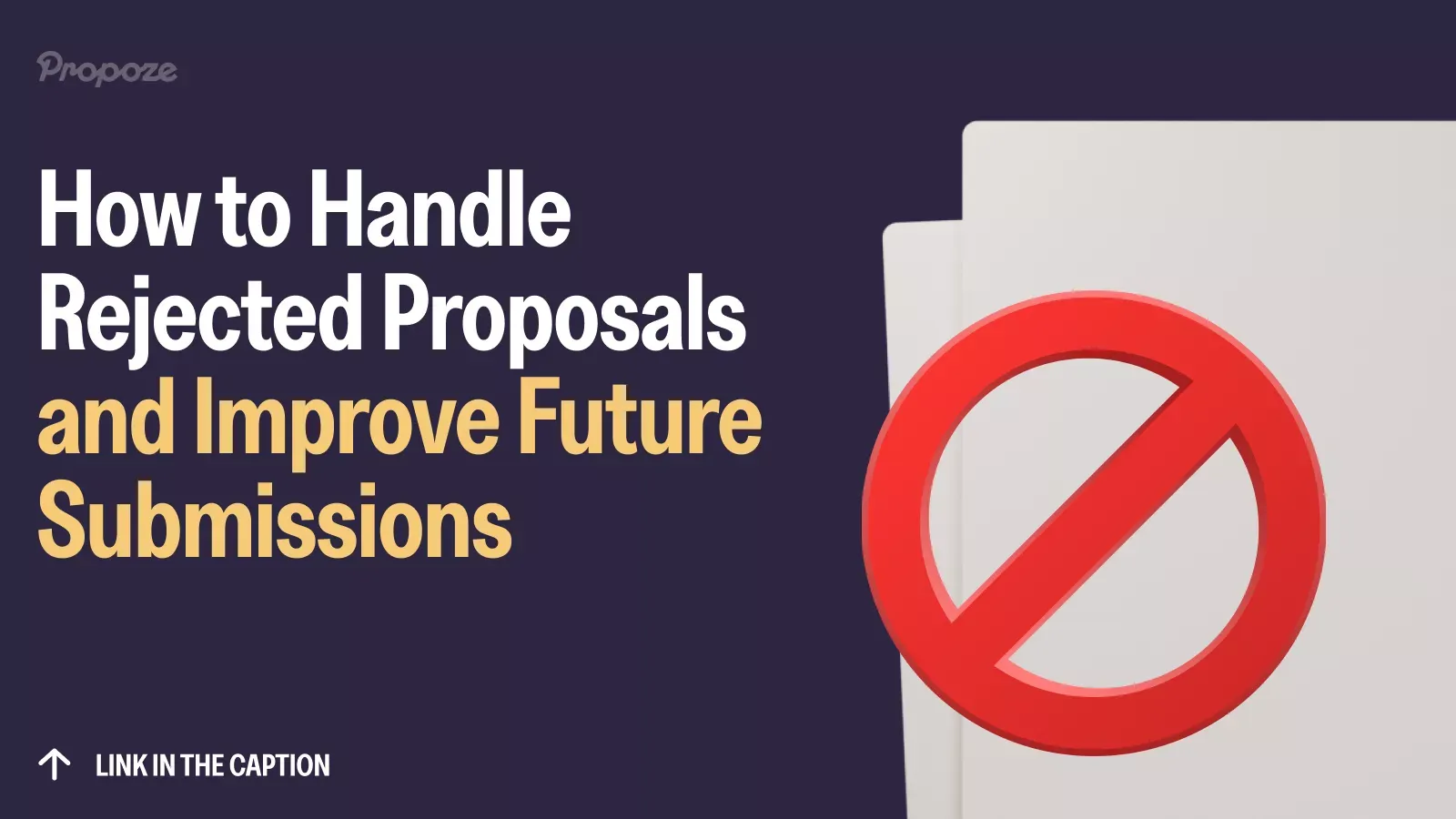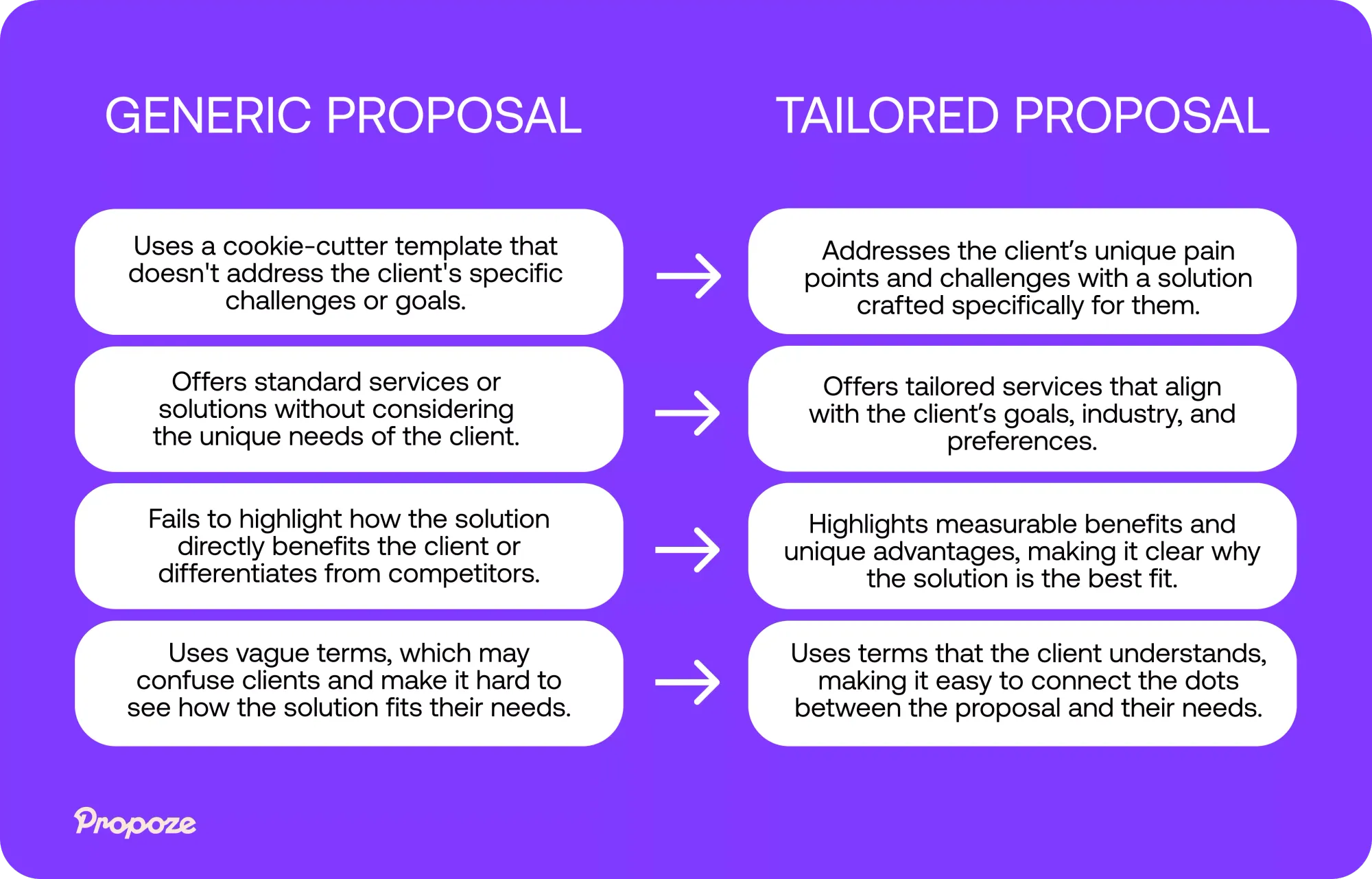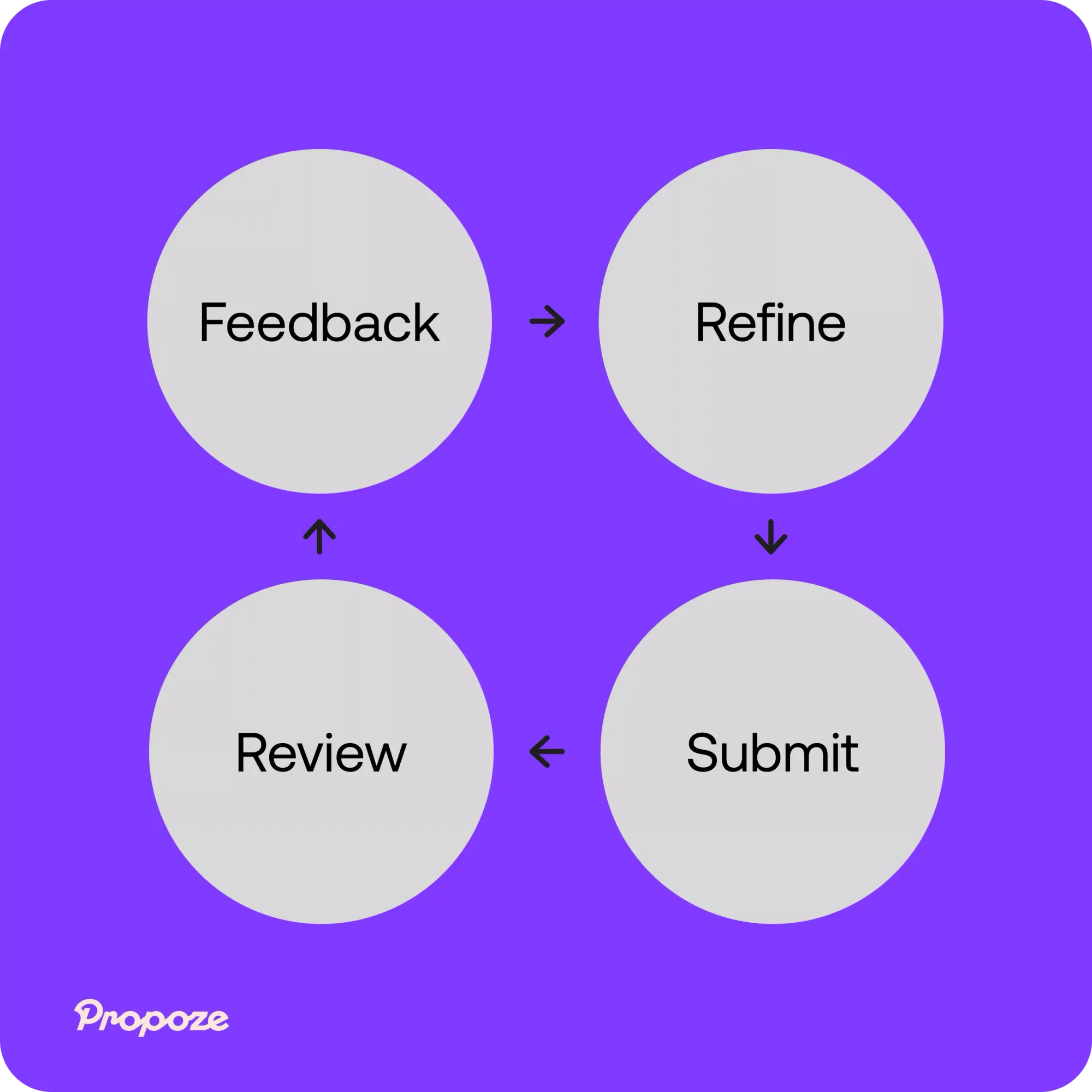How to Handle Rejected Proposals and Improve Future Submissions
Learn how to transform feedback into winning proposals and impress your next client.
— Propoze

Receiving a rejected proposal can be frustrating, but it's also a chance to learn and improve.
Rather than seeing it as a setback, handling rejection constructively allows you to strengthen your proposals and increase future success rates. Each rejection offers valuable insight into client expectations, proposal presentation, and communication strategies.

By analyzing feedback, refining your approach, and leveraging tools like Propoze, you can turn rejections into stepping stones for growth and significantly boost your proposal acceptance rate.
In this post, we’ll go over some of the most common reasons for rejected proposals — and provide you with step-by-step strategies to improve your proposal success rate!
Let’s dive right in.
What are the most common reasons for proposal rejection?
Handling rejection effectively means understanding the most common reasons proposals fail.
Let’s break them down.
1) Misalignment with client needs
One of the most common reasons for proposal rejection is failing to align with what the client truly needs.
Clients are looking for solutions that directly address their unique challenges, so a one-size-fits-all approach doesn’t work. If your proposal feels generic or misses key issues, they may feel you haven’t done your homework.
Why does this matter?
When clients see that you’ve tailored your proposal to their specific goals, it builds trust.
This alignment shows that you’ve listened and understood their needs, positioning you as a partner rather than just another vendor.

How to ensure that the proposal is aligned with client needs?
Here are 6 concrete actions you can take to make sure your proposal fits your client's needs.
1. Conduct thorough research
Before drafting a proposal, dive into the client’s business. Review their website, read case studies, check for any news about their industry, and look for insights about their market challenges. This research allows you to understand their pain points and address them directly.
2. Ask specific questions
In discovery calls or meetings, go beyond surface-level questions. Ask what’s been working for them, what hasn’t, and what success looks like for their business. For example, if a client is struggling with lead generation, focus on solutions that improve conversion rates rather than offering a broad marketing package.
3. Customize your proposal language
Reflect the client’s own language and terminology in your proposal. For instance, if a client refers to “scaling operations” in meetings, use the same phrase in your proposal. This reinforces that you understand their goals and makes the proposal feel more personalized.
4. Address pain points directly
In each section of your proposal, be clear about how your solution solves the client’s specific problem. For example, if they’re concerned about inefficiencies, outline how your solution will streamline their process and save time. Make the connection between their pain points and your offering explicit.
5. Provide industry-specific examples
Whenever possible, include case studies or success stories from clients in the same industry. This not only builds credibility but also reassures the client that you understand the unique challenges of their sector.
6. Tailor the solution
Avoid giving a one-size-fits-all solution. Highlight which parts of your service or product will be tailored specifically to the client’s needs. For example, instead of a standard service package, offer a customized version based on their feedback from initial conversations.
For example, imagine we’re proposing a digital marketing campaign for an e-commerce company focused on reducing abandoned carts. If your proposal emphasizes SEO or social media ads, you’re missing the mark.
Instead, offer targeted strategies like email retargeting and personalized product recommendations. This level of detail shows you understand their challenge and have the right tools to fix it.
2) Poor proposal structure
An unclear proposal structure can be a deal-breaker, no matter how good your content is.
If your proposal lacks organization or is hard to follow, clients may become frustrated and abandon it altogether.
Why does this matter?
Clients want to quickly find key details like pricing, timelines, and deliverables. A messy layout makes it harder for them to evaluate your proposal and can lead to rejection.

How to improve your proposal structure?
Here are 5 specific actions you can take to improve your proposal structure.
1. Organize with clear sections
Structure your proposal into easy-to-follow sections: Introduction, Deliverables, Pricing, and Next Steps. This helps clients know exactly where to find information.
2. Include a table of contents
For longer proposals, a table of contents is essential. It allows clients to jump to relevant sections quickly without scrolling endlessly.
3. Use headings, bullet points, and short paragraphs
Clients won’t read large blocks of text. Use headings and bullet points to break up the content and highlight important details. Short paragraphs also make the proposal more scannable, improving the client’s reading experience.
4. Make good use of white space
White space is more than just aesthetic—it makes content easier to read. Proposals crammed with text can be overwhelming. Use white space to guide the reader's eye through the document.
5. Highlight key information
Use bold text or different colors to make important sections like pricing or project milestones stand out. This ensures clients see the most critical parts without having to search.
For example, let’s imagine we’re submitting a 20-page proposal where pricing is buried in the middle of dense text.
The client may miss it entirely or become frustrated trying to locate it.
Instead, with a well-organized layout and clear headings, clients can easily navigate to the pricing section and quickly grasp your offer, improving the chances of winning the project.

3) Unclear value proposition
A weak or unclear value proposition is one of the top reasons proposals get rejected. If clients can’t immediately see why your solution is the best fit, they’re unlikely to move forward.
Why does this matter?
Because clients want to know what’s in it for them.
If your proposal fails to highlight the benefits and unique value you bring, they won’t see why they should choose you over competitors.
How to clarify your value proposition?
Here are 5 steps you can take to clarify your value proposition.
1. Make the benefits clear
Instead of listing services, explain the direct benefits to the client. For example, instead of saying "we provide marketing services," say, "we’ll increase your lead generation by 20% within six months."
2. Focus on outcomes, not features
Clients care more about the results you’ll deliver than the specific features of your service. Highlight measurable outcomes like improved efficiency, cost savings, or increased revenue.
3. Tailor the value to the client
Your value proposition should speak directly to the client’s unique needs. Use the information you’ve gathered about their pain points to show how your solution is the answer. For instance, if the client needs faster project delivery, emphasize how your approach shortens timelines.
4. Use metrics and case studies
Whenever possible, include real metrics and case studies that demonstrate your past successes. Clients want proof that you can deliver results. Include data points like, “We helped a similar company reduce their costs by 15% within the first quarter.”
5. Make it easy to find
Ensure that your value proposition is front and center in your proposal. Don’t bury it in dense text—use bold headings and bullet points to make it stand out. This helps clients immediately understand why you’re the right choice.
Let’s take a look at a quick example.
Imagine we’re submitting a proposal to a SaaS company. In the proposal, we just list our software development services without specifying how our work can help them increase user acquisition.
By clearly stating, “We’ll help you boost user engagement by 25% through optimized onboarding features,” you give them a tangible reason to choose you.
Learn from your proposal feedback
Feedback after a rejected proposal is a goldmine for improving future submissions.
Instead of viewing rejection as a dead end — use it as an opportunity to refine your proposals and align more closely with client needs.

How to learn from your proposal feedback?
Here’s how to turn a proposal rejection into valuable feedback.
1. Actively seek feedback
After a rejection, reach out to the client and ask for insights. A simple, non-confrontational question like “Could you share any feedback to help us improve?” opens the door to valuable advice.
2. Identify patterns
If you receive multiple rejections, look for recurring themes in the feedback. Are clients mentioning similar issues, like pricing concerns or lack of clarity in deliverables? Spotting these trends allows you to target specific areas for improvement.
3. Adapt based on feedback
It’s not enough to collect feedback—you need to act on it. For instance, if several clients say your pricing structure was unclear, revisit that section in your proposal and make it more transparent. If they mention that your value proposition wasn’t strong enough, focus on better articulating the unique benefits of your solution.
4. Make feedback part of your process
Treat feedback as an ongoing learning tool. Incorporate it into your proposal strategy, track how the changes impact future success, and continuously refine your proposals based on what you learn.
Now, one last piece of advice for learning from feedback.

Identify patterns in your proposal rejections
Tracking the reasons behind rejected proposals is key to making strategic, data-driven improvements.
If you repeatedly face rejections, there’s likely a pattern. Identifying that pattern will help you refine your proposals.
How to track rejections:
- Record client feedback: Maintain a log of client feedback for each rejected proposal.
- Analyze common themes: Are clients frequently citing pricing issues, unclear deliverables, or misaligned goals? Spotting these trends helps target specific areas for improvement.
- Make data-driven adjustments: Use these insights to tweak proposal structure, messaging, or pricing based on recurring feedback patterns.
Identifying these recurring issues and making adjustments is the key to improving your proposal success rate.
3 strategies to improve your future proposals
Ready to level up your proposals? In the next sections, we'll cover specific strategies that can help turn those rejections into wins.
Whether it's fine-tuning your value proposition, improving the structure, or making your proposals more personalized, we've got you covered. Each strategy is designed to help you build stronger, more targeted proposals that speak directly to your clients' needs.
Let’s dive into the key areas that will take your proposals from “almost” to “accepted”!
1) Personalize and customize your proposal
Let’s face it — no one likes a generic, one-size-fits-all proposal.
Personalizing your proposal shows clients you truly understand their specific needs and challenges, making it much more likely they’ll choose you.
Why does this matter?
Personalization builds trust and makes clients feel valued. It shows you’ve done your homework and are offering a tailored solution just for them.
How to personalize your proposals:
- Speak their language: Use industry-specific terms and address the client’s pain points directly.
- Tailor your solutions: Customize deliverables, timelines, or pricing based on their goals.
- Show you've listened: Address their pain points directly, like optimizing workflows or cutting costs.
Let’s go with a quick example.
Imagine you’re pitching to a healthcare provider. Instead of offering a generic software package, you reference their industry’s strict compliance needs and customize the proposal to show how your solution ensures privacy and meets regulatory standards. This level of personalization helps win the deal.
2) Highlight your value proposition
At the heart of any successful proposal is a strong, clear value proposition. Clients need to know exactly why they should choose you and what results they can expect.
Why does this matter?
A clear value proposition shows clients the ROI they’ll get and differentiates you from competitors. It’s about making your offer compelling and relevant to their needs.
How to highlight your value proposition:
- Quantify results: Use numbers to highlight the impact. Instead of general promises, say something like “We’ll reduce your costs by 15% in the first six months.”
- Show what makes you different: Emphasize your unique strengths—whether it’s faster delivery, specialized expertise, or exceptional support.
- Use client testimonials: Real-life success stories help back up your claims. A quote from a happy client adds credibility.
- Highlight long-term benefits: Don’t just focus on immediate results—explain how your solution offers lasting value, such as reducing ongoing costs or improving efficiency over time.
- Add visuals: Use charts or graphs to make your value clearer and more compelling at a glance.
- Tailor the value to the client: Customize your proposal by addressing specific pain points the client is facing. If they’re concerned about costs, highlight the cost-effectiveness of your solution. If speed is the issue, focus on how you’ll save them time.
Here’s a simple example of a highlighted value proposition.
Say you’re pitching to a tech startup that’s struggling with project delays.
Instead of simply offering project management services, show how your process has cut timelines by 20% for similar clients, and back it up with a testimonial. This kind of specificity helps seal the deal.

3) Improve your proposal design and presentation
Your proposal’s design is the first thing clients notice, and it sets the tone for how they view your professionalism and attention to detail.
Why does it matter?
A messy or cluttered proposal can distract from your message.
On the other hand, a clean, well-organized one makes you look polished and on top of things. It also helps clients absorb key information faster.
How to improve design and presentation:
- Use white space: Break up the content and make it easier to read. Think about how much more digestible a well-spaced website feels compared to one crammed with text.
- Consistent branding: Make sure your fonts, colors, and style are on point. This keeps your proposal looking cohesive and professional. You can even use tools like Propoze for consistent, branded templates.
- Include visuals: Add graphs or charts to visually represent key data points. For example, use a graph to show potential ROI or timelines. Tools like Piktochart or Venngage are great for creating simple visuals.
- Clear headings: Use bold, descriptive headings so clients can quickly navigate to the sections they care about.
- Professional cover page: A personalized cover page, with the client’s name and your company’s logo, creates a polished, personal touch.
- Concise text blocks: Keep paragraphs short and to the point. Long blocks of text can feel overwhelming, so break it up for easier reading.
Here’s a simple example.
Picture two proposals — one with dense paragraphs and another with clean sections, easy-to-scan headings, and visuals that reinforce the message.
Which one would grab your attention more? You already know.
Thoughtful design keeps clients engaged and helps your proposal stand out.

Never stop improving your proposals!
If you want your proposals to keep improving over time, a continuous improvement process is essential.
This means creating a proposal library and using a feedback loop to keep refining your approach.
By continuously improving your proposals, you’ll:
- Stay relevant: Your clients' needs evolve, and so should your proposals. Keeping them fresh ensures you always meet expectations.
- Save time: A well-maintained proposal library lets you build customized proposals quickly, without starting from scratch each time.
Here’s how to do it:
- Build a proposal library: Store templates for common industries or services, so you never build from zero. Organize them by client type or project category for easy access.
- Create a feedback loop: After every proposal submission, ask the client for feedback. Did they find your proposal clear? Was the pricing breakdown easy to follow? Use this input to adjust your templates and improve future proposals.
- Track performance: Keep an eye on which proposals perform best. Are there certain layouts or elements that consistently win? Focus on refining these winning aspects.
The key is to treat each proposal as a learning opportunity, tweaking and refining your approach with each submission. Over time, this constant refinement will make your proposals sharper, more relevant, and much harder to reject.
Ultimately, it’s about evolving with your client’s needs and making sure that every proposal you send is better than the last.
Turn your rejected proposals into winning opportunities
Improving your proposals is an ongoing journey.
It’s all about learning from feedback, fine-tuning your approach, and using data to make smarter decisions. The more you refine your proposals, the more likely you are to build stronger client relationships and increase your success rate.
Whether it’s improving how you communicate value or tweaking your presentation, constant evolution is key.
Propoze makes this process easier by helping you track, manage, and improve each proposal. Over time, you’ll create proposals that are not only faster but more targeted and effective.
And every time you create a proposal, you can rest assured that it will look beautiful and visually impressive. Now, that’s one worry less!
Give Propoze a try and sign up for our free trial!